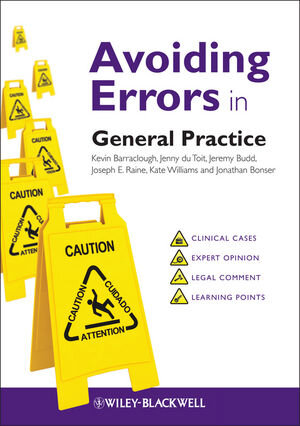
„My experience as an expert witness in clinical negligencecases, MPTS Panel chairman, medical adviser to a Public Inquiry andas a sometimes commissioned independent reporter on adverseincidents tells me that these are excellent books, valuable for allclinicians, not just those in high-risk specialties; and all NHSmanagers involved in maintaining or improving the quality of care. The case vignettes, alone, are useful source material for teachingmedical trainees on what can go wrong and how to deal with it whenit does.“ (Harvey Marcovitch, Clinical Riskjournal)
„This is a tremendous exercise in critical thinking skills, i. e. the ability to think through differential diagnoses andlonger-term consequences beyond the simple facts presented. Thisbook has great learning value for young and midcareer clinicians tohelp them hone their diagnostic skills.“ (Doody's, 5 July 2013)
„This excellent 182-page book is designed for generalpractitioners in their early years. It will be a very useful sourcefor all involved in teaching and mentoring those in generalpractice, and should, I think, be compulsory reading for allpractice managers. It is so packed with information, concepts andcase studies written in decent English that I found it difficult toput down.
The first section gives a resume of the law concerningbreach of medical duty, including the Bolam test. Causation, damages and time limits for litigation are discussed. Protocols, guidelines and communications are considered followed by a heartfelt appeal to learn from system failures. This is what I wantpractice managers to read.
The next section looks at how an initial diagnosis isreached, and then refined. Avoiding being misled by firstimpressions by testing against a differential diagnosis, excludingdiagnoses that must not be missed, considering non-fitting facts, and follow up review all help. Making arrangements to review thecase if the illness does not follow the expected course canretrieve the situation, and a record of this can save areputation.
Communication is recognised as the core of safe practice. I likethe simple concept “Ask yourself whether a colleague couldwork out from your notes the essential details of theconsultation.„
Then follows the real meat of the book. This consists offorty recent clinical cases, each demonstrating a particularmishap. These forty cases bring up 95% of causes of complaintsagainst general practitioners. Each describes a case in a fewwell-chosen sentences, and asks the reader what they think, andmight do next. For example, make a differential diagnosis, orperform further simple examinations. An expert opinion is thengiven on what good practice would involve. This is followed by alegal opinion of the case, including the likely range of damages orsettlement. Some of the sums are unnerving! Each case takes up justtwo pages.
The book ends with the various enquiries and courts that may befaced, and practical advice on addressing them.
I sincerely hope that other practitioners and practice managerswill find this little book as thought provoking as I have.“(Daniel Haines, FRCGP, MFFLM.)
Written for Foundation Year doctors, trainees and generalpractitioners, and unlike any other clinical management titleavailable, Avoiding Errors in General Practice identifiesand explains the most common errors likely to occur in anoutpatient setting - so that you won't make them.
The first section in this brand new guide discusses the causes oferrors in general practice. The second and largest section consistsof case scenarios and includes expert and legal comment as well asclinical teaching points and strategies to help you engage in saferpractice throughout your career. The final section discusses how todeal with complaints and the subsequent potential medico-legalconsequences, helping to reduce your anxiety when dealing with theconsequences of an error.
Invaluable during the Foundation Years, Specialty Training and forConsultants, Avoiding Errors in General Practice is theperfect guide to help tackle the professional and emotionalchallenges of life as a GP.



